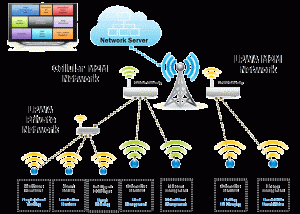LPWA Networks and ISM Bands could be the next logical extension of IoT. Read to know more on The Pros and Con’s.
Machina Research published just recently a new Strategy Report that explores the technological landscape of Low Power Wide Area (LPWA) networks and their use in the IoT. It is a topic that remains very high on our research agenda, and one of the key themes that we have been studying as part of these efforts is spectrum use. Thus far, the LPWA networks have been deployed almost exclusively in unlicensed spectrum, by using what are known as ISM (Industrial, Scientific, and Medical) bands. The licensed model will, in turn, become reality once the cellular-based LPWA technologies become available, although we expect to see also at least some LoRaWAN networks being operated in licensed bands.
In short, you can’t have your cake and eat it: both approaches come with their own compromises. In the following, let’s discuss particularly the unlicensed model further, as it after all represents such an intriguing departure from the established way of doing things.
The ISM bands have for a long time been an essential part of modern data communications, serving as the bloodline for Wi-Fi, Bluetooth and a variety of other wireless technologies. The trend that one can currently see in the IoT space is a logical extension to how these bands have been employed previously. What is different this time, though, is the drive to use them namely as a foundation for wide-area networks, since this puts them in a rather probable collision course (pun intended) with each other. With short-range technologies, the overlapping of several networks tends to cause a variety of technical everyday hiccups, but such problems tend to be so limited that this has never become an issue on the strategic level – in the sense that multiple operators’ coexistence within the same geographical area could one day realistically pose an existential threat to one or more of them. If the unlicensed flavour of LPWA truly takes off, then that situation definitely cannot be ruled out.
 See, there is a good chance that increasingly crowded ISM bands would turn the unlicensed LPWA into another example of the tragedy of the commons – with all parties independently aiming to maximise their use of a scarce resource, resulting in its “depletion” to everybody’s disadvantage. This may happen if a number of different ISM-based LPWA technologies are deployed overlapping each other, and if most of them end up serving a substantial number (say, tens of thousands per cell) of endpoints, which then communicate multiple times a day. It is uncertain how effectively the providers could address signal interference and collision in such circumstances.
See, there is a good chance that increasingly crowded ISM bands would turn the unlicensed LPWA into another example of the tragedy of the commons – with all parties independently aiming to maximise their use of a scarce resource, resulting in its “depletion” to everybody’s disadvantage. This may happen if a number of different ISM-based LPWA technologies are deployed overlapping each other, and if most of them end up serving a substantial number (say, tens of thousands per cell) of endpoints, which then communicate multiple times a day. It is uncertain how effectively the providers could address signal interference and collision in such circumstances.
Individually, they can add more gateways to the area, and thus scale down the cell size, but this remedy has its limits if all of the providers take advantage of it and also increases the costs for each provider. Ultimately, an unlicensed LPWA network’s performance is largely beyond the provider’s own direct control.
If the overcrowding scenario materialises, regulators will have several ways to address it. The first one is to release more spectrum for unlicensed use, as overcrowding would imply that the unlicensed LPWA model, as a whole, has been successful and there is a genuine market need to support it further. The second one is to keep the amount of spectrum more or less at the same, but limit duty cycle and other device parameters further.
(In this context, it should be noted that one national regulator Machina Research has spoken with pointed that the enforcement of such limitations, with the available resources, is not necessarily straightforward to begin with.) The third, and the most dramatic, one is to scrap the existing ISM model and licence most of the bands applicable to wide-area networks to qualified providers, possibly retaining a slice of the spectrum as unlicensed but reserving it for uncommercial use. The fourth approach would be a lighter-touch variant of the third one: keeping the spectrum itself free to use, but requiring anyone operating a commercial wide-area network to obtain a licence, with certain conditions.
Right now, the regulatory future of unlicensed LPWA does not have much relevance beyond this kind of semi-casual thought exercise. Telecoms regulators, however, may want to plan well ahead in this case, since if the theme one day does become relevant then the stakes will be high indeed.
Courtsey:http://www.iot-now.com/2015/12/16/40214-lpwa-networks-and-ism-bands-iot-cornerstone-or-tragedy-of-commons/















